- Letter names and sounds
- Spelling and rhyme
- Sentence structure and writing
Letter names and sounds with Connetix
Learning the alphabet and the sounds letters make can be a fun play experience for all. Letter sounds and names can be taught either together or separate. Some educators prefer to teach letter sounds first ‘A for apple’, some prefer to teach letter names ‘the letter A’. Whichever way you choose, there is some fun to be had with Connetix tiles.
1: LEARNING LETTERS & SOUNDS
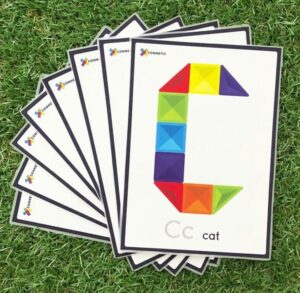
Let’s start with some alphabet/sound play. Learning to recognise the different letters of the alphabet, and that they are different to other symbols around them, helps children to launch their literacy journey. Early recognition of letters has been linked to reading success later in life.
Did you know Connetix have free Alphabet and Number download cards? These are so great for just simple recognition of what each English letter of the alphabet looks like (they also have Spanish, French and Mandarin cards on their website too).
Play Idea: Use letter cards and create them with Connetix. By ‘copying’ the letter cards, this can also lead to knowledge in letter formation and later handwritten skills.
2: ALPHABETICAL ORDER
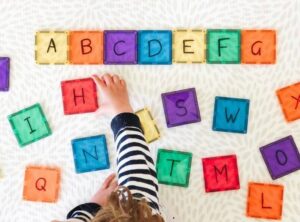
Ordering alphabet letters is an important skill for little ones to learn. Knowing the order of the alphabet gives children a simplified way to understand and remember each letter of our alphabetic system. Alphabetic order is a lifelong and practical skill. Think about looking up a word/name as an adult, most systems work in alphabetic order. It improves phonetic understandings, spelling skills and is the first skill young children require before learning to read.
Play Idea: Connetix tiles can be used to create Alphabet “cards” with a chalk marker or whiteboard marker (please test beforehand as some cheaper markers can stain; also make sure to wipe off immediately after play). Leave out the written letters on Connetix tiles and listen to the alphabet song with your child. They may wish to put them in order with you!
3: UPPER AND LOWERCASE LETTERS
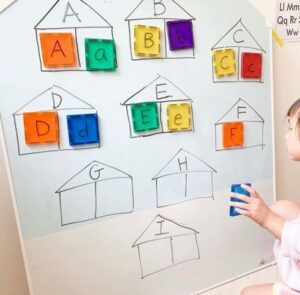 Uppercase and lowercase letters are also an important grammatical skill. Through incidental learning, you can give your child a head start with learning literacy.
Uppercase and lowercase letters are also an important grammatical skill. Through incidental learning, you can give your child a head start with learning literacy.
Play Idea: Use Connetix tiles to make ‘houses’ on a whiteboard for your child to match.
4: INITIAL SOUNDS

Is your child starting to learn first or initial sounds? Sound matching is an excellent activity for this!
Play Idea: Draw pictures for them to sort, write short words and ask your child to ‘post’ them into Connetix cubes. What a fun way to play and consolidate learning.
5: SOUND – SPELLING PRACTICE
 Another step up is consonant-vowel-consonant sound spelling. Or even just letter matching to make words! It all helps and adds to the learning to read experience.
Another step up is consonant-vowel-consonant sound spelling. Or even just letter matching to make words! It all helps and adds to the learning to read experience.
Play Idea: Match sounds to make words and then match whole words. (Please note: the long ‘ar’ sound included in this sort may be confusing if your little one is just learning short sounds.)
6: DIGRAPHS
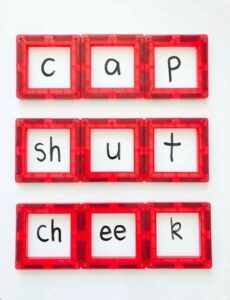
As your child gets older or more experienced in learning sounds, adding digraphs in their sound knowledge bank may be helpful. Digraphs are when two letters make one sound. It can be made up of consonants, like ‘sh’ or vowels ‘oo’.
Play Idea: Use Connetix windows to identify digraphs. Children will enjoy the sensory factor of ‘clicking’ the magnets together. For older children you may prompt them to build a structure using these words for an extra challenge.
Spelling and rhyme with Connetix
7: RHYMING
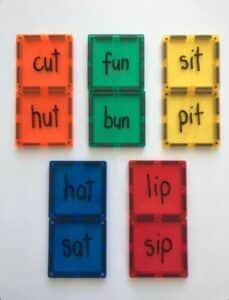
Rhyming is one of the first spelling activities. Learning how to rhyme is an important literacy skill. It teaches children so much about the English language, such as sounds, listening carefully to our language and that it is made up of separate parts.
Play Idea: Connetix Rhyme Puzzle. As Connetix are coloured, you can give ‘hints’ for young children to have success in learning these rhyming sounds by writing rhyming pairs on the same colours. If your child cannot read, you can draw the pictures or read for them.
8: WORD FAMILIES
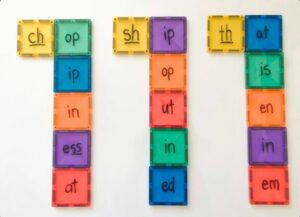
Word families are words that have a common origin, for example, words that have the same beginning or ending (suffix and prefixes).
Play Idea: Word Family Puzzle. This is aimed at children who are currently learning to read. They will be able to match and manipulate these prefixes in order to understand related words.
9: SPELLING
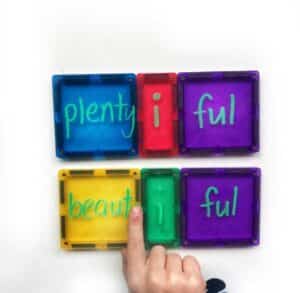 As children move through learning to read, they will also go through stages of learning how to write and spell. Check out these fun ways to learn ways to spell in a classroom or home-school setting.
As children move through learning to read, they will also go through stages of learning how to write and spell. Check out these fun ways to learn ways to spell in a classroom or home-school setting.

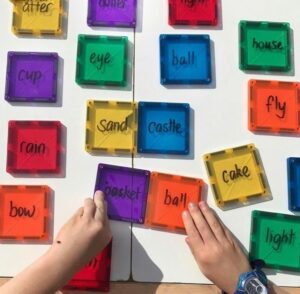
Sentence structure and writing
10: SENTENCE BUILDING

Simple sentence writing, story boarding and sentence structure can also be taught using Connetix tiles.
Play Idea: Colour code sentences for children learning about sentence structure. For example, sectioning the sentence into articles, nouns, verbs, and so on. When children see them colour coded they may be able to develop an understanding about sentence structure.
Connetix magnetic tiles assist in learning through play and the interests of the child to develop literacy learning. As an effective home and classroom resource, magnetic tiles are an excellent way for children to enjoy and connect with literacy learning. Have you tried some of our ideas and activities? We would love to hear from you! If you want to share your play or be featured, email [email protected]. Don’t forget to check our Pinterest folders for more ideas!

